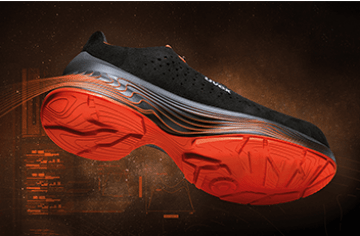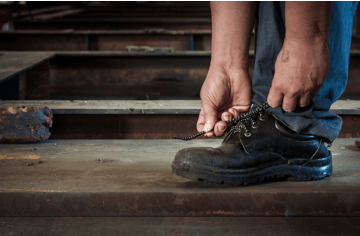Work shoes need replacing on a regular basis. But how do you know when it’s time to buy a new pair? After all, it’s not always obvious by looking at the shoes themselves.
What happens when your work shoes wear out?
When work shoes wear out, they become less safe and less comfortable to wear. Worn-out work shoes can cause pain in the knees and back. When work shoes no longer support the feet sufficiently, expensive, personalised insoles can become necessary. Also, after wearing them for a long time, work shoes become less effective in regulating moisture and absorbing shock. Colleagues will start to complain and there will be a feeling of irritation in the workplace.
6 ways to know when it’s time for new work shoes
Even with good maintenance, the time will still come when you need to buy new work shoes. There are various signs that will tell you that your work shoes are due for replacement.
Watch out for these signs, in order to protect the health and safety of your colleagues.
1. The work shoes are (more than) one year old
Work shoes generally need replacing after one year. They may still look fine. You may think that you can use them for another year. However, appearances can be deceiving: some wear and tear is invisible. Although the wearer can still be affected.
2. Visible damage
An obvious sign is visible damage. For example, a tear in the sole, or a dent in the reinforced or steel toe cap. However limited the damage, this can significantly affect safety and comfort. So, do replace damaged shoes as quickly as possible.

3. Invisible damage
Has a heavy or sharp object fallen on the shoes? Sometimes the damage, for example a tear, is only on the inside of the work shoe. Or a tear is still too small to notice, but increases gradually. That’s why it’s better to buy new work shoes straight after an accident.
4. The work shoes feel uncomfortable when standing or walking
Good support of the feet is important for the wearer’s health. Support deteriorates with use. This means you can start to feel the strain in your ankles, knees and back. Worn-out work shoes can even cause absenteeism due to (chronic) injury. Shoes also become less effective in absorbing shock as time goes on. The wearer will also start to notice this when walking. Therefore, it is important to replace work shoes when they no longer fit snugly or feel good when walking. In doing so, you’ll spare your colleagues from sore feet or back pain at the end of the day.

5. Wear and tear on the sole
An anti-slip sole can become smoother due to wear and tear. You may not see this when you look at the work shoes, but you’ll notice it when you’re walking. Smooth soles are also more dangerous, as the wearer can slip over. You also need to watch the soles in the case of anti-static shoes. Anti-static shoes provide protection against static electricity, but worn soles can cause life-threatening situations. Safety is a priority, so never wait too long before replacing this type of work shoe.

6. The work shoes remain damp
Do you notice that work shoes increasingly fail to dry by the next morning? That means that the moisture regulation is less effective. It is likely that lingering salt from perspiration has clogged the lining. This means that new perspiration is less able to escape and remains in the lining. This is also a clear sign that it’s time to order a new pair of work shoes.
Maintenance: why is this important?
Of course, you don’t want to buy new work shoes unnecessarily. Luckily, there are things you can do to help. Follow these maintenance tips and your work shoes will remain in good condition for longer.
- Clean your work shoes: Always wipe off dirt and dust from your shoes with a brush or damp cloth after wearing.
- Care for your work shoes: Clean your safety shoes regularly, and grease leather shoes from time to time. This will keep the leather supple, and help keep cracks at bay.
- Alternate your shoes: Work shoes get wet due to sweat, or e.g. when working in the rain. By alternating your work shoes, you give them time to dry out completely. In this way, they will remain in good condition for longer. Of course, this means you will need at least two pairs of work shoes.
Do you want more tips to care properly for your work shoes? Also read: 11 tips to take good care of your work shoes.
Conclusion
Good maintenance means you can use your work shoes for longer. Even so, you will generally need to swap them for a new pair after a year (or so). Unless the work shoes are damaged or uncomfortable of course. Is it time for some new work shoes? Check out our full range of work shoes. We would naturally be delighted to help you in making the best choice.








